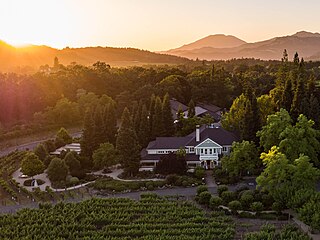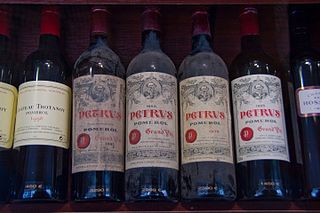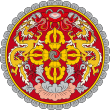Related Research Articles

Merlot is a dark blue–colored wine grape variety that is used as both a blending grape and for varietal wines. The name Merlot is thought to be a diminutive of merle, the French name for the blackbird, probably a reference to the color of the grape. Its softness and "fleshiness," combined with its earlier ripening, make Merlot a popular grape for blending with the sterner, later-ripening Cabernet Sauvignon, which tends to be higher in tannin.

Cabernet Sauvignon is one of the world's most widely recognized red wine grape varieties. It is grown in nearly every major wine producing country among a diverse spectrum of climates from Australia and British Columbia, Canada to Lebanon's Beqaa Valley. Cabernet Sauvignon became internationally recognized through its prominence in Bordeaux wines, where it is often blended with Merlot and Cabernet Franc. From France and Spain, the grape spread across Europe and to the New World where it found new homes in places like California's Napa Valley, New Zealand's Hawke's Bay, South Africa's Stellenbosch region, Australia's Margaret River, McLaren Vale and Coonawarra regions, and Chile's Maipo Valley and Colchagua. For most of the 20th century, it was the world's most widely planted premium red-wine grape until it was surpassed by Merlot in the 1990s. However, by 2015, Cabernet Sauvignon had once again become the most widely planted wine grape, with a total of 341,000 hectares (3,410 km2) under vine worldwide.

Pinot noir, also known as Pinot nero, is a red-wine grape variety of the species Vitis vinifera. The name also refers to wines created predominantly from Pinot noir grapes. The name is derived from the French words for pine and black. The word pine alludes to the grape variety having tightly clustered, pinecone—shaped bunches of fruit.

Cabernet Franc is one of the major black grape varieties worldwide. It is principally grown for blending with Cabernet Sauvignon and Merlot in the Bordeaux style, but can also be vinified alone, as in the Loire's Chinon. In addition to being used in blends and produced as a varietal in Canada, the United States and Argentina, it is sometimes made into ice wine in those regions.

Malbec is a purple grape variety used in making red wine. The grapes tend to have an inky dark color and robust tannins, and are known as one of the six grapes allowed in the blend of red Bordeaux wine. In France, plantations of Malbec are now found primarily in Cahors in South West France, though the grape is grown worldwide. It is also available as an Argentine varietal.

Chile has a long history in the production of wine, with roots dating back to the 16th century when the Spanish conquistadors introduced Vitis vinifera vines to the region. In the mid-19th century, French wine varieties such as Cabernet Sauvignon, Merlot, Carmenère, and Cabernet Franc were introduced. During the early 1980s, the Chilean wine industry underwent a renaissance with the introduction of stainless steel fermentation tanks and the use of oak barrels for aging. This led to a rapid growth in exports as quality wine production increased. The number of wineries in Chile rose from 12 in 1995 to over 70 in 2005.

The Carménère grape is a wine grape variety originally planted in the Médoc region of Bordeaux, France, where it was used to produce deep red wines and occasionally used for blending purposes in the same manner as Petit Verdot.

Château Lafite Rothschild is a French wine estate of Bordeaux wine, located in Pauillac in France, owned by members of the Rothschild family since the 19th century, and rated as a First Growth under the 1855 Bordeaux Classification.

Bordeaux wine is produced in the Bordeaux region of southwest France, around the city of Bordeaux, on the Garonne River. To the north of the city, the Dordogne River joins the Garonne forming the broad estuary called the Gironde; the Gironde department, with a total vineyard area of 110,800 hectares, is the second largest wine-growing area in France behind the Languedoc-Rousillon.

Tannat is a red wine grape, historically grown in South West France in the Madiran AOC, and is now one of the most prominent grapes in Uruguay, where it is considered the "national grape".

Washington wine is a wine produced from grape varieties grown in the U.S. state of Washington. Washington ranks second in the United States in the production of wine. By 2017, the state had over 55,000 acres (220 km2) of vineyards, a harvest of 229,000 short tons (208,000 t) of grapes, and exports going to over 40 countries around the world from the 940+ wineries located in the state. While there are some viticultural activities in the cooler, wetter western half of the state, the majority (99.9%) of wine grape production takes place in the shrub-steppe eastern half. The rain shadow of the Cascade Range leaves the Columbia River Basin with around 8 inches (200 mm) of annual rain fall, making irrigation and water rights of paramount interest to the Washington wine industry. Viticulture in the state is also influenced by long sunlight hours and consistent temperatures.

The wine regions of Bordeaux in France are a large number of wine growing areas, differing widely in size and sometimes overlapping, which lie within the overarching wine region of Bordeaux, centred on the city of Bordeaux and covering the whole area of the Gironde department of Aquitaine.

Priorat is a Denominació d'Origen Qualificada (DOQ) for Catalan wines produced in the Priorat county, in the province of Tarragona, in the southwest of Catalonia.

The Duckhorn Portfolio Inc. is an American wine company producing varietal labelled and blended red, white, rosé, and sparkling wines from California and Washington State. The main winery, Duckhorn Vineyards, is outside St. Helena, California.

The South Australian wine industry is responsible for more than half the production of all Australian wine. South Australia has a vast diversity in geography and climate which allows the state to be able to produce a range of grape varieties–from the cool climate Riesling variety in the Clare Valley wine region to the big, full bodied Shiraz wines of the Barossa Valley.

Turkish wine is wine made in the transcontinental Eurasian country Turkey. The Caucasus region, where Armenia, Azerbaijan, Georgia and Iran are located, played a pivotal role in the early history of wine and is likely to have been one of the earliest wine-producing regions of the world.

Ornellaia is an Italian wine producer in the DOC Bolgheri in Toscana, known as a producer of Super Tuscan wine. Ornellaia is considered one of Italy's leading Bordeaux-style red wines. The estate also produces a second wine, Le Serre Nuove, the blend Le Volte, the Merlot-labeled varietal wine Masseto, in addition to estate production of grappa and olive oil. In 2012, the winery's name was changed from "Tenuta dell'Ornellaia" to "Ornellaia e Masseto", in recognition of the increasing importance of the Merlot-based wine.

Pomerol is a French wine-growing commune and Appellation d'origine contrôlée (AOC) within the Libournais in Bordeaux. The wine produced here is predominately from Merlot with Cabernet Franc playing a supporting role. Unlike most other Bordeaux communes, there is no real village of Pomerol, although there is a church. The houses are set among the vineyards.

Champoux Vineyard is a grape growing estate located in the Horse Heaven Hills AVA of Washington state. Grapes grown in the vineyard have been used to produce some of the most critically acclaimed Washington wines with the name Champoux regularly being featured on vineyard designated wines. Paul Gregutt, wine writer for the Seattle Times and Wine Enthusiast, list Champoux as one of the "top ten" vineyards in the entire state. Cabernet Sauvignon grapes from Champoux vineyards were featured in the consecutive 100 point Robert Parker rated wines from Quilceda Creek Vintners for the 2002 and 2003 vintages.

Force Majeure is a Washington/Oregon wine estate, specializing in Syrah, Cabernet Sauvignon as well as other Bordeaux and Rhone-inspired blends. The brand was founded in 2004, and beginning with that vintage began the "Collaboration Series" of wines made by some of Washington's top winemakers, using fruit from Red Mountain's Ciel du Cheval vineyard. Since 2014, the wines have been made by acclaimed winemaker Todd Alexander, who moved from the Napa Valley to the Pacific Northwest at that time. The brand labels also changed in 2014, to signify the winemaking change and the use of their estate vineyards for the wines, going forward. Todd Alexander continues to craft these limited production wines to this day.
References
- ↑ Robinson, Jancis; Harding, Julia (2015). The Oxford Companion to Wine. Oxford University Press. p. 80. ISBN 9780198705383.
- ↑ Avieson, Bunty (2015-04-01). The Dragon's Voice: How Modern Media Found Bhutan. University of Queensland Press. p. 76. ISBN 9780702253577.
- ↑ "THE GRAPES & VINEYARDS". Bhutan Wine Company.
- ↑ "First vineyards planted in Bhutan". www.thedrinksbusiness.com. 5 April 2019.
- ↑ "Bhutan Wine Company (@BhutanWine) | Twitter". twitter.com.
